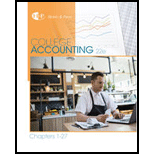
Concept explainers
(a)
Compute
(a)
Explanation of Solution
Accounts receivable turnover:
Accounts receivable turnover is a liquidity measure of accounts receivable in times, which is computed by dividing “the net credit sales by the average amount of net accounts receivables”. In other words, it indicates the number of times the average amount of net accounts receivables collected during a particular period. The formula to calculate the accounts receivable turnover ratio is as follows:
Average collection period:
Average collection period indicates the number of days taken by a business to collect its outstanding amount of accounts receivable on an average.
Calculate accounts receivable turnover ratio:
Therefore, the accounts receivable turnover ratio is 5.14.
Working note:
(1) Calculate the average accounts receivables:
Calculate average collection period:
Therefore, average collection period is 71.01 days.
(b)
Compute merchandise inventory turnover ratio and average number of days to sell inventory.
(b)
Explanation of Solution
Merchandise Inventory turnover ratio:
Inventory turnover ratio is used to determine the number of times inventory used or sold during the particular accounting period. The formula to calculate the merchandise inventory turnover ratio is as follows:
Days’ sales in inventory:
Days’ sales in inventory are used to determine number of days a particular company takes to make sales of the inventory available with them.
Calculate merchandise inventory ratio:
Therefore, merchandise inventory ratio is 3.16.
Working note:
(2) Calculate average inventory:
Calculate average number of days to sell inventory:
Therefore, average number of days to sell inventory is 115.51 days.
(c)
Calculate asset turnover ratio.
(c)
Explanation of Solution
Asset turnover ratio:
Asset turnover is a ratio that measures the productive capacity of the assets to generate the sales revenue for the company. Thus, it shows the relationship between the net sales and the average total assets. The formula to calculate the asset turnover ratio is as follows:
Calculate asset turnover ratio:
Therefore, asset turnover ratio is 1.34:1.
Working note:
(3) Calculate average assets:
Want to see more full solutions like this?
Chapter 24 Solutions
College Accounting, Chapters 1-27
- KD Industries has 30 million shares outstanding with a market price of $20 per share and no debt. KD has had consistently stable earnings and pays a 35% tax rate. Management plans to borrow $200 million on a permanent basis through a leveraged recapitalization in which they would use the borrowed funds to repurchase outstanding shares. The present value of KD's interest tax shield is closest to a. $130 million b. $200 million c. $400 million d. $70 millionarrow_forwardCorrect answer please general accountingarrow_forwardTargeted pre tax income?arrow_forward
- Please provide the correct answer to this financial accounting problem using accurate calculations.arrow_forwardIf a country can give up one unit of future consumption and as result increase its current consumption by 0.94 units, its real rate of interest must be: (a) 1.4% (b) 3.4% (c) 6.4% (d) 9.4%arrow_forwardWhat is the total contribution margin??arrow_forward
 College Accounting, Chapters 1-27 (New in Account...AccountingISBN:9781305666160Author:James A. Heintz, Robert W. ParryPublisher:Cengage LearningPrinciples of Accounting Volume 1AccountingISBN:9781947172685Author:OpenStaxPublisher:OpenStax College
College Accounting, Chapters 1-27 (New in Account...AccountingISBN:9781305666160Author:James A. Heintz, Robert W. ParryPublisher:Cengage LearningPrinciples of Accounting Volume 1AccountingISBN:9781947172685Author:OpenStaxPublisher:OpenStax College Managerial AccountingAccountingISBN:9781337912020Author:Carl Warren, Ph.d. Cma William B. TaylerPublisher:South-Western College Pub
Managerial AccountingAccountingISBN:9781337912020Author:Carl Warren, Ph.d. Cma William B. TaylerPublisher:South-Western College Pub Financial And Managerial AccountingAccountingISBN:9781337902663Author:WARREN, Carl S.Publisher:Cengage Learning,
Financial And Managerial AccountingAccountingISBN:9781337902663Author:WARREN, Carl S.Publisher:Cengage Learning, Financial AccountingAccountingISBN:9781337272124Author:Carl Warren, James M. Reeve, Jonathan DuchacPublisher:Cengage Learning
Financial AccountingAccountingISBN:9781337272124Author:Carl Warren, James M. Reeve, Jonathan DuchacPublisher:Cengage Learning Survey of Accounting (Accounting I)AccountingISBN:9781305961883Author:Carl WarrenPublisher:Cengage Learning
Survey of Accounting (Accounting I)AccountingISBN:9781305961883Author:Carl WarrenPublisher:Cengage Learning





